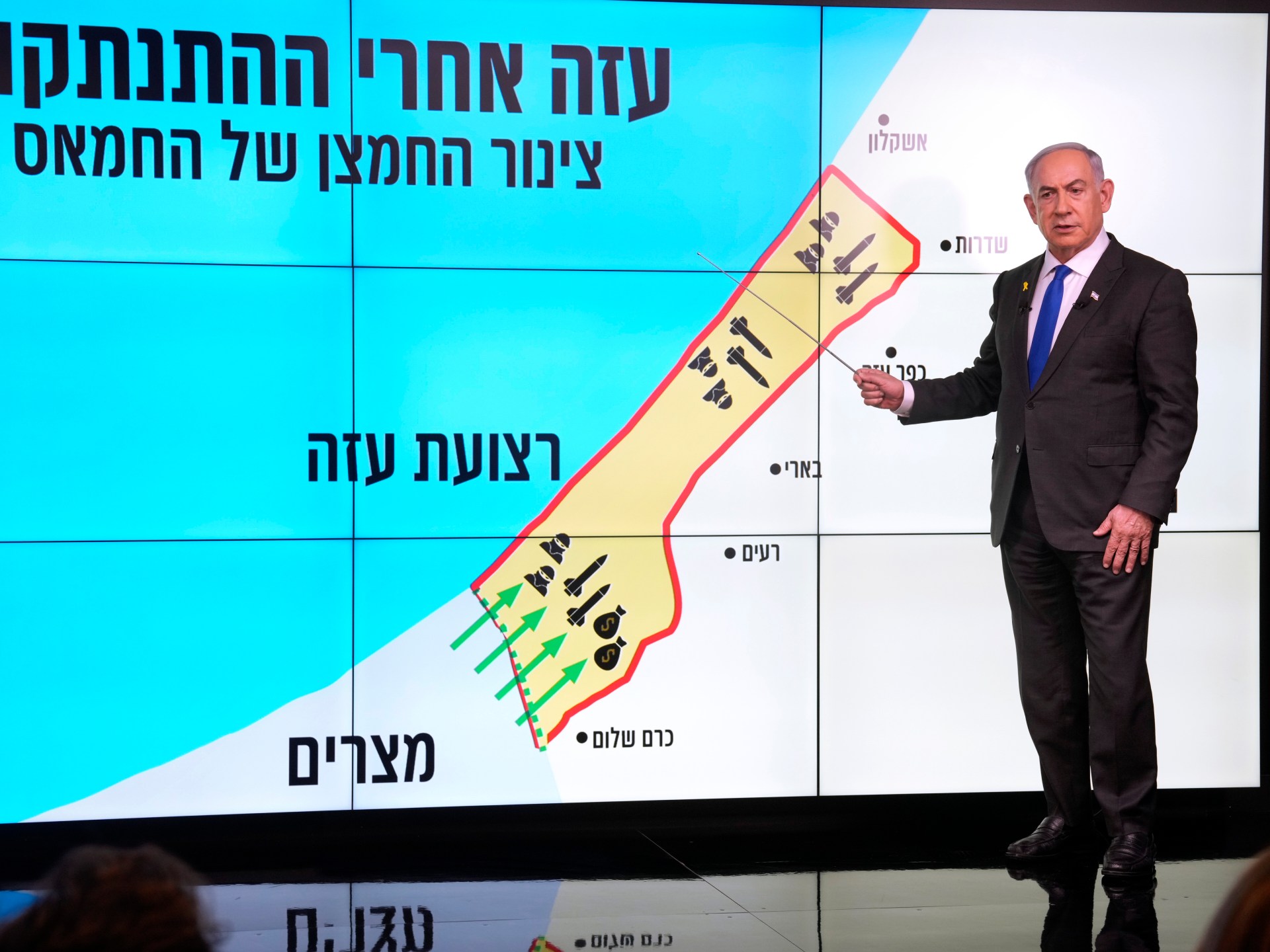On September 2, Israel’s Prime Minister Benjamin Netanyahu went on TV to talk about the war on Gaza.
After the Palestinian group Hamas led an operation on October 7, during which 1,139 people in Israel died and another 250 or so were taken captive, Israel launched a war on Gaza, killing more than 40,000 Palestinians there.
International and internal pressure has built on Netanyahu to come to a ceasefire agreement that would see the Israeli captives returned in exchange for an end to the fighting and a release of Palestinians prisoners.
But Netanyahu’s news conference signalled that he had no intent of agreeing to a ceasefire.
Instead, he presented a plan for the future of Palestine. Here’s all you need to know about it:
What was this all about?
When Netanyahu appeared on television, he stood in front of a giant map with a pointer held tightly in his hand. The map had cartoonish bombs drawn on Gaza, interspersed with cartoon “masked men”.
He was there to give a slick presentation about what he wanted to do in the besieged Gaza Strip, ostensibly, but notably absent on the map was the occupied West Bank.
What does he want to do to Gaza?
Netanyahu’s presentation suggested partitioning Gaza into three parts, making it unrecognisable.
He wants to keep the entire area north of an axis the Israeli army cut through the Strip under Gaza City, the Netzarim Corridor, destroyed.
There would be no reconstruction and people would not allowed to go back to their homes.
This, he claimed, would be so Israeli forces could work to dismantle any tunnel infrastructure or Hamas “nests” in that area.
The southernmost strip of land in Gaza, the Philadelphi Corridor, would remain under Israeli military control, while a new third corridor would be built between Rafah and Khan Younis and also be controlled by Israel.
But Netanyahu does not want Israel to be bogged down in managing the affairs of more than two million civilians it plans to keep displaced, he suggested instead that a local civil authority take care of those.
What about the occupied West Bank?
Well, as we mentioned above, his plan seemed to erase the occupied West Bank.
The map Netanyahu tapped on for emphasis showed the West Bank as completely annexed into Israel.

This comes as Israeli assaults on refugee camps and towns in the occupied West Bank reach new highs, a display of what may well be Netanyahu’s end goal.
Why the Philadelphi Corridor?
Philadelphi lies on the Egypt border, and Netanyahu has been claiming that only Israel can control that border crossing to stop Hamas from smuggling the captives it has out of Gaza or smuggling weapons and other contraband in.
Despite several public statements by people from within his own cabinet and security establishment, he’s been painting it as a “cornerstone” of Israel’s security.
But analysts believe Netanyahu’s focus on the Philadelphi Corridor is for a different reason: trying to derail a ceasefire agreement.
“It’s basically an excuse that Netanyahu is using at this point,” Zachary Lockman, an expert on Israel-Palestine at New York University, told Al Jazeera.
Why would Netanyahu want to derail a ceasefire?
Excellent question. This insistence on the Philadelphi Corridor is holding up negotiations – also because mediator Egypt is completely opposed to Israel being there.
No ceasefire means the captives taken into Gaza on October 7 will not be coming back anytime soon, a fact that is enraging their families, friends and fellow Israelis who are protesting in huge numbers.

This all seems like a situation Netanyahu should want to avoid, and yet he isn’t. Analysts and even some US officials are saying that he actually intends to hold up the ceasefire negotiations in order to prolong his time in power and to avoid dealing with corruption cases against him.
So Israeli troops are staying in Gaza?
According to Netanyahu’s proposed plan, yes.
Israel maintains control of the Netzarim Corridor which splits the north and south of Gaza and the Philadelphi Corridor, which borders Egypt.
Furthermore, the “security buffer” Israel has built in the Gaza Strip would remain in place and Israel would take a broad strip of land in the north of Gaza.
Will aid at least be finally allowed into Gaza?
According to a map shared by Itay Epshtain on X, two zones would be set up – one in the Netzarim Corridor and one in the new corridor that will separate Rafah and Khan Younis.
This is where aid would theoretically be distributed, creating pull factors to keep people focused around those two axes.




![Tyson Foods Plant [Photo: Food Manufacturing]](https://southarkansassun.com/wp-content/uploads/2023/08/iStock_1185520857__1_.5e441daa51cca-600x337.jpg)







![Silverado Senior Living Management Inc. [Photo: Los Angeles Times]](https://southarkansassun.com/wp-content/uploads/2023/10/download-6-4-600x337.jpg)

![China's Wuhan Institute of Virology [Photo: Nature]](https://southarkansassun.com/wp-content/uploads/2023/09/d41586-021-01529-3_19239608-600x337.jpg)
















